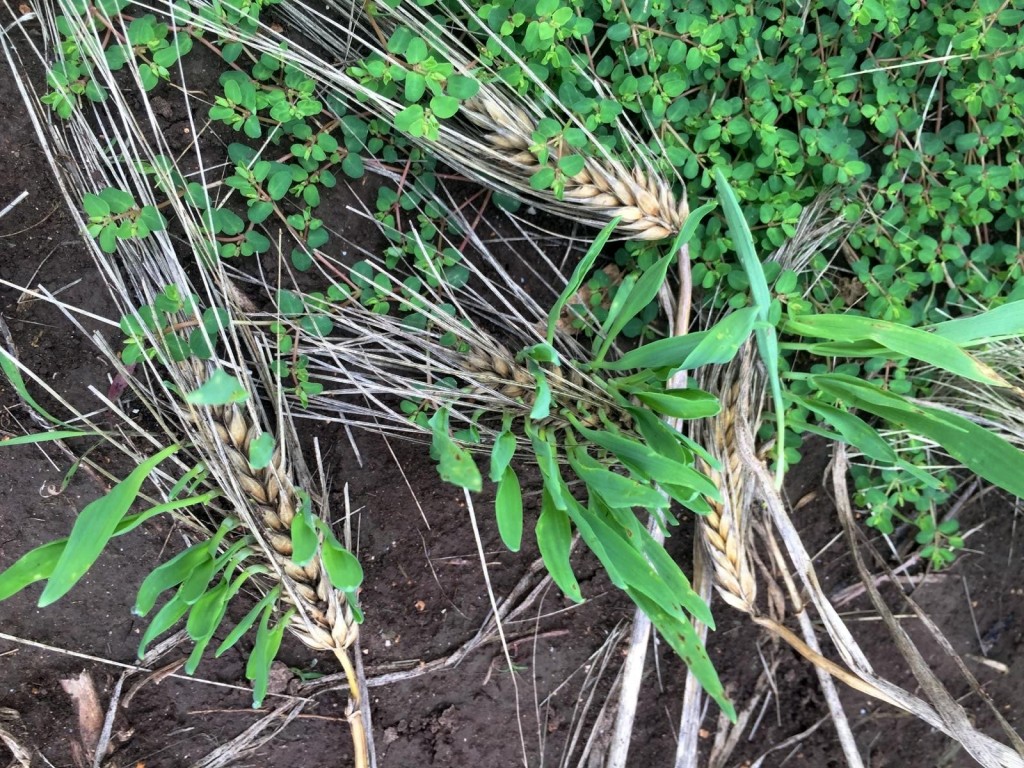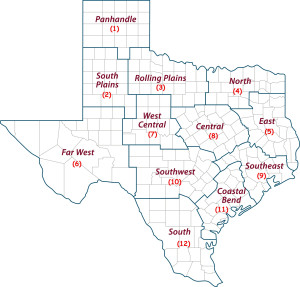HOME
Texas crop, weather for June 16, 2015
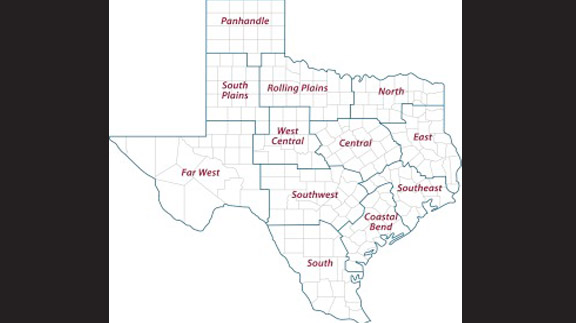
By: Robert Burns
Pre-harvest wheat sprouting not as severe as anticipated
Writer: Robert Burns, 903-834-6191, [email protected]
COLLEGE STATION – In late May, it appeared many wheat growers were poised to suffer big discounts because of pre-harvest sprouting of winter wheat, said a Texas A&M AgriLife Extension Service agronomist.
“In the Blacklands and East Texas, from the reports I’ve heard, the sprouting is fairly widespread but not quite as severe as we first anticipated,” said Dr. Clark Neely, AgriLife Extension small grains and oilseed specialist in College Station.
“I’ve heard a lot of reports of producers getting 1 or 2 percent sprouting, which generally doesn’t elicit too much dockage at the elevator,” Neely said. “I also heard of some reports of producers getting loads rejected that had 10 to 20 percent sprouting. Elevators can either reject or impose severe dockage when the sprouting gets that high.”
Download or preview a two-minute MP3 audio version of this report
“I think the sprouting was not as severe due to the fact that once it got wet, it stayed wet,” Neely said. “Sprouting becomes worse each time it goes through a wet and then dry period, but in many cases this year once the fields got wet, they never dried out until recently, and then they were harvested soon after.”
That isn’t to say Central and East Texas wheat growers haven’t had other problems, such wheat being laid down in the fields from high winds and heavy rains, along with hail and increased fungus diseases, Neely said.
Rolling Plains wheat is just now reaching physiological maturity with harvesting beginning some places, and sprouting does not appear to be a major problem there, he said.
“I think we dodged the bullet for the most part in that part of the state,” Neely said. “Wheat has to reach physiological maturity before sprouting becomes an issue.”
As of June 12, “High Plains wheat was still in soft or hard dough stage, and sprouting hasn’t been a concern there thus far,” he said. “However, forecasts indicate another 5-plus inches of rain for parts of the Panhandle. And if that pattern continues over the course of the next couple of weeks we could run into many of the same issues the Blacklands growers were facing earlier this season.”
AgriLife Extension district reporters compiled the following summaries:
Central: Soil moisture, rangeland and pastures, and livestock were all in good condition. Crops were generally in fair condition. Producers were harvesting hay; everyone expected good yields, averaging four to six big round bales per acre. Oats and wheat were in poor condition, and harvesting was proceeding slowly. Grain sorghum and corn were in poor condition because of the long-lasting, overly wet conditions. Pecan orchards we re looking very good. Stock-water tanks were full, and creeks were flowing.
Coastal Bend: Hot, dry conditions persisted until the weekend, allowing farmers and ranchers to get some much-needed fieldwork done. Many hay fields were top dressed with fertilizer. Insect pressure was increasing on sorghum, including sugarcane aphids. With less standing water in fields, crops were improving. Southern corn rust of corn was found, but most corn was mature enough that yield losses were not expected. Soybeans were flowering and setting pods. A lot of hay was harvested during the last couple of weeks. The demand for replacement heifers was extremely strong. Livestock and pastures remained in good shape.
East: The region had many sunny days. Producers took advantage of the drier weather to bale hay where they could get into the fields. Hay quality suffered due to over-maturity of the forage, but quantities were good. Producers also were able to do some spraying and fertilization as pastures dried out. Most counties changed their ratings of subsoil and topsoil moisture from surplus to adequate. Cherokee County had grasshopper infestations. Floodwaters along the Trinity River receded somewhat, but some Anderson County fields of grain sorghum and corn were a total loss due to long-term standing water. Some Henderson County vegetable producers had total losses due to flood damage. Truck farmers continued to battle the lingering results of the overly wet spring and early summer, which included higher populations of insects as well as fungi. Trees were also showing results of too much moisture. The blueberry and blackberry harvests began. Cattle were generally in good to excellent condition, though some producers were reporting foot rot in their herds. Producers continued to sell market-ready and cull cows. Mosquito and fly numbers further increased. Feral hogs continued to damage fields and crops.
Far West: Hot and windy weather prevailed throughout. Ward and Presidio counties had a few thunderstorms. Cotton, corn, sunflowers and grain sorghum plantings were completed, and the wheat harvest was in full swing across the region. Pasture and rangeland were in good condition. Subsoil and topsoil moisture were adequate.
North: Topsoil moisture was mostly adequate with a few counties reporting short. The previous week was mostly dry with temperatures reaching the mid-90s. Some areas received a trace to 0.25 inch of rain. The hot, humid days made for excellent forage growing conditions. The harvesting of wheat began, with early reports of average yields of about 50 bushels per acre. However, test weights were low. Some fields still had soggy areas, making harvest a little difficult. What little corn was planted looked alright, though stands were very uneven, which was probably due to areas that earlier had standing water. The same held true for grain sorghum and soybeans. Hay producers were taking an early season hay crop; the hay was overly mature as it should have been harvested about three weeks ago. Hay yields were below average with low quality. Pastures looked very good because of all the spring rains. There were reports of pneumonia in c attle. There were many disease and fungal issues in crops, as well as large numbers of spider mites.
Panhandle: The week started off dry and windy, but more rain came during the weekend. Temperatures were nearly normal for mid-June. Soil moisture continued to be mostly adequate. Collingsworth County producers tried to catch up on planting until the area received as much as 5 inches of rain. Acres not planted in cotton will likely be switched over to grain sorghum. Stock-water tanks were replenished, and pastures were greening up nicely. Deaf Smith County producers were also trying to catch up on the planting of all crops, including corn, sunflowers, grain sorghum and hay crops. Wheat was suffering from diseases and problems associated with hail and earlier freeze problems. Corn planting was nearly finished. Some Hansford County dryland wheat was not in that great of shape; other fields were looking good. The wheat harvest was expected to start soon. Areas around the city of Gruver and north of Spearman in Hansford County re ceived 2-inch diameter hail, which may have damaged wheat and cornfields. Corn planting was almost complete, and some sorghum planting began. Cattle were making great gains on grassland. Weeds were starting to become a problem. Hemphill County received about 2.5 inches of rain; many parts of the county have received 20 inches and more for the year. Cows and calves were making extremely good gains as grass was plentiful. Heavy rains in Lipscomb County over the weekend washed out planted corn that had not yet germinated. Because of rain, Randall County producers were only able to plant about 40 percent of intended cotton acreage and only 60 percent of the corn. Most producers will plant grain sorghum in place of the lost cotton and sorghum acreages. Sorghum acreage in Randall County was expected to go up some 40 percent.
Rolling Plains: Wheat yields were good on the fields not destroyed by earlier severe weather conditions. Cotton producers were able to plant a lot of cotton, raising hopes for average to better yields. Soil moisture was good. June 12 rains stopped harvesting and saturated soils again. Livestock were in generally excellent condition. Rangeland and pastures were in good condition. Lakes and stock-water tanks were full.
South: The weather was dry and warm with no rain except for some light, scattered showers. Rangeland and pastures were fair to excellent throughout the region, with fair to good being the most common ratings. In the northern part of the region, peanut planting was completed and there was some hay harvested. Wheat harvesting was completed in some areas. Potato harvesting continued, and peanut planting was in full swing. Early planted cotton was flowering, while late-planted cotton was squaring. Grain sorghum was heading, and corn was in the soft-dough stage. Soil moisture was adequate through the northern counties. In the eastern part of the region, warmer weather with scattered showers allowed row crops to progress rapidly. Well-drained grain sorghum fields headed out, but wetter fields were not progressing on schedule. Corn was maturing in fields that began to dry out. Cotton was well behind schedule but was expected to catch up soon. There were some reports of thrips on cotton. Soil moisture conditions were adequate to surplus in the eastern counties. In the western part of the region, no rain was received, but planting was still delayed in some counties as a result of wet field conditions. Irrigation producers began applying water to corn, cotton, sorghum and pecans. Soil moisture was adequate in Dimmit County, but 100 percent short in Zavala County. In the southern part of the region, sunflower harvesting began, and corn, cotton and sorghum were in good condition. Hay harvesting continued in Starr County. Soil moisture was adequate in the southern counties.
South Plains: A few dry days enabled most producers to get cotton planted before the crop insurance deadline. More rains came Friday, Saturday and Sunday to many counties. The wheat harvest started, but the rains kept producers out of fields for the weekend. Hale County had heavy rains and lots of weeds. Cochran crops were in excellent condition, but subsoils and topsoils were starting to dry out. Pastures and rangeland remained in good condition. Lubbock County received 2 to 3 inches from the weekend rains. Some hail hit the southern half of the county, but the extent of the damage was yet to be determined. In Garza County, the cotton-planting deadline was June 10, which the majority of producers met on most of their cotton acreage. Mitchell County producers got a lot of acres planted before the weekend rains, which should help emergence in some fields; in other fields, the rains put the crop under water.
Southeast: Soil moisture varied widely, but was mostly adequate to surplus. Rangeland and pasture ratings were mostly good to excellent, with good ratings being the most common. In Montgomery County, drier weather allowed for some hay harvesting and herbicide applications. A few showers came late in the week but amounted to less than 1 inch. Brazoria County producers were preparing for the coming tropical storm. Fort Bend County row-crop producers were finally able to get into fields. Livestock were in good condition with plenty of grass to eat.
Southwest: Rangeland, crops and forages were responding well to last month’s rains. Some counties received an additional 2 to 4 inches this week, and the runoff improved the levels of stock-water tanks. Some counties needed more rain to improve soil moisture. Horn fly populations continued to increase. Producers finished their first hay cutting. The remaining wheat was harvested, though a significant amount was lost due to flood damage. Livestock were in good condition but will need to be monitored for internal parasites and flies in the coming weeks because of the earlier wet conditions.
West Central: Days were hot and humid, with scattered showers in a few areas that continued to hinder crop harvesting. Soil moisture was good, and stock-water tanks and pond levels were high. Where conditions permitted, producers were busy cutting and baling hay, and getting above-average yields. Cotton planting was in full swing. Early planted cotton was off to a good start. Grain sorghum looked great. The wheat harvest was underway where producers were able to get into the fields. Wheat yields were fair to good. Rangeland and pastures were in great shape and continued to improve. Weed control was still an issue. Flies and mosquitoes were abundant in many areas. All classes of livestock were in good to excellent condition.
-30-
HOME
Farm and Ranch Injuries
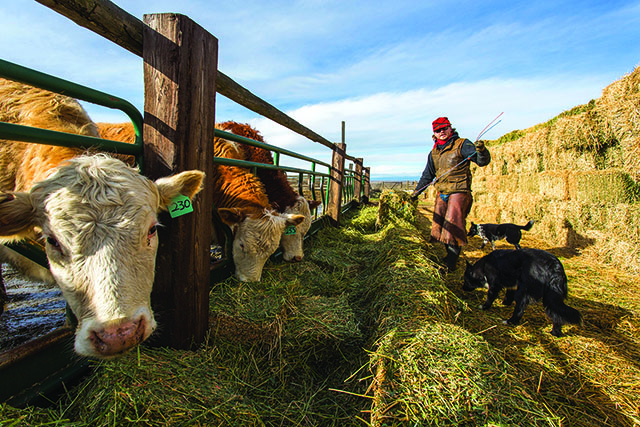
By Barry Whitworth, DVM
In January, I attended the Oklahoma Veterinary Conference. While waiting for one of the sessions to start, a classmate of mine commented how many of the attendees walk with a limp, used a cane, and/or have damaged hands. We all agreed that working with animals is hard on the body. In general, anything associated with farming and ranching is dangerous.
Most farmers and ranchers know that agriculture is a dangerous occupation. According to United States Bureau of Statistics, workers involved in agriculture, forestry, and fishing had the highest occupational fatality rate in 2022. The fatality rate of 23.5 per 100,000 full-time equivalent (FTE) workers for this group is much higher when compared to the overall occupation fatality rate of 3.7 per 100,000 FTE. Most of the agriculture-related fatalities are associated with transportation, such as tractor overturns, and vehicle crashes, but a fair number involve livestock.
To read more, pick up a copy of the March issue of NTFR magazine. To subscribe by mail, call 940-872-5922.
HOME
Jesses Jewelz

By Jesse Kader
Comfy and keep it western. That’s the name of the game this month. It’s hot and who wants clingy clothing? This jumpsuit is perfectly comfortable and relaxed without forfeiting the fashion. Dress it up or keep it casual. See this and more at www.jessesjewelz.com.
HOME
Noble Research Institute Expands New Program Offering Farmers and Ranchers the Essentials of Regenerative Ranch Management
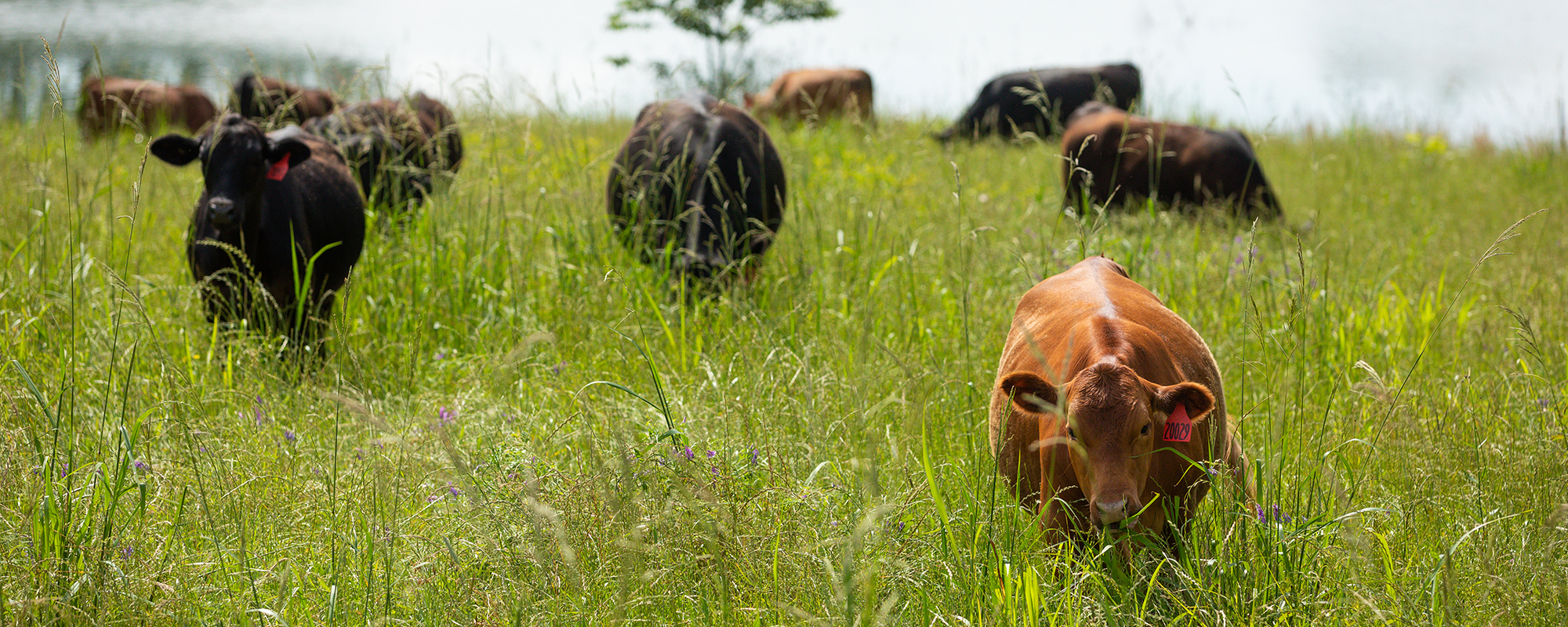
The educational program has been expanded to three new locations, empowering ranchers and farmers to monitor and improve the health of their land, livestock and livelihood through regenerative principles.
ARDMORE, OK–September 12, 2023 – Noble Research Institute announced the expansion of Essentials of Regenerative Ranching, a new educational program designed to help ranchers enhance and restore the land, making it more resilient and reaching livestock grazing goals through regenerative management. Essentials of Regenerative Ranching provides producers with practical tools, hands-on experience and guidance to make data-driven decisions to decrease costs and improve profit.
The Essentials of Regenerative Ranching course has been expanded to three new locations in Texas and Oklahoma. Registration is open now at www.noble.org/essentials. Seating is limited, so early registration is recommended.
Texas A&M
College Station, Texas
October 17 – 18
O.D. Butler, Jr. Animal Science Complex
Noble Research Institute
Ardmore, Oklahoma
October 31 – November 1
Pavilion Center
Texas A&M
Kingsville, Texas
November 7-8
Caesar Kleberg Wildlife Center
“Program participants gain working knowledge and experience of monitoring and improving the health of their soil, grazing livestock more strategically and making informed financial decisions,” said Hugh Aljoe, Noble Research Institute’s director of ranches, outreach and partnerships. “We use a mix of classroom and field work to send producers home with the tools they need to begin making changes on their ranch.”
Farmers and ranchers navigate uncertainty from weather, fluctuating market prices and escalating costs of inputs. Many producers are seeking new tools that offer greater control and reduce their operational uncertainty. Through this course, ranchers and farmers will calculate their financial situations, determine initial stocking rates, carrying capacity and grazing goals.
“The course is well-suited for ranchers of all experience levels and all types and sizes of operations,” Aljoe added. “No matter your situation, this program will transform the way you think about your ranch.”
The Essentials of Regenerative Ranching program allows producers to overcome obstacles, become more informed problem-solvers and increase the productivity of their grazing lands. By participating in this program, ranchers join a community of like-minded producers who are shaping the future of ranching and leaving a lasting impact on their land and families. “If I had known what I learned in this course when I started my regenerative journey, I could have avoided some key mistakes,” said Tana McCarter, a rancher, and Essentials attendee. “I left with the tools I needed to monitor my soil health and financial progress. I’ll now have the right data to make informed decisions on how to meet my regenerative goals.”
Noble Research Institute is an independent nonprofit agricultural research organization dedicated to guiding farmers and ranchers in applying regenerative principles that yield healthier soil, more productive grazing land, and business success.
At Noble, researchers, facilitators and ranch staff work together to share with farmers and ranchers the skills and tools to regenerate the land in a profitable manner. Noble is focused on the regenerative management of the nation’s grazing acres, which directly impacts pasture and range environments, wildlife, pecan production, and livestock production. Regenerative management recognizes that each decision made on the ranch impacts the interactions of the soil, plants, water, animals, economics and people. Noble’s 14,000 acres of working ranch lands provide a living laboratory on which to demonstrate and practice regenerative principles and ideas to deliver value to farmers and ranchers across the U.S.
-

 Country Lifestyles1 year ago
Country Lifestyles1 year agoScott & Stacey Schumacher: A Growth Mindset
-

 Equine7 months ago
Equine7 months agoThe Will to Win
-

 Country Lifestyles7 years ago
Country Lifestyles7 years agoStyle Your Profile – What your style cowboy hat says about you and new trends in 2017
-

 Country Lifestyles4 years ago
Country Lifestyles4 years agoAmber Crawford, Breakaway Roper
-

 HOME7 years ago
HOME7 years agoGrazing North Texas – Wilman Lovegrass
-

 Country Lifestyles7 years ago
Country Lifestyles7 years agoDecember 2016 Profile, Rusty Riddle – The Riddle Way
-

 Country Lifestyles8 years ago
Country Lifestyles8 years agoJune 2016 Profile – The man behind the mic: Bob Tallman
-

 Country Lifestyles8 years ago
Country Lifestyles8 years agoCowboy Culture with Clay Reid – Being a Man

